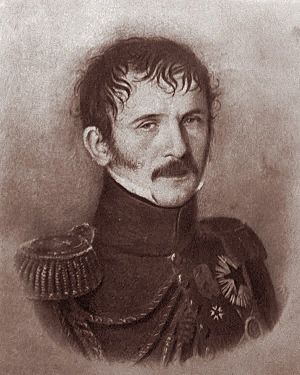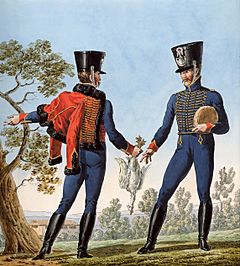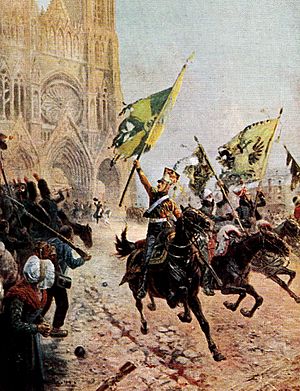Christophe Antoine Merlin facts for kids
Quick facts for kids
Christophe Antoine Merlin
|
|
|---|---|

General of Division Christophe Antoine Merlin
|
|
| Born | 27 May 1771 Thionville, France |
| Died | March 9, 1839 (aged 67) Paris, France |
| Allegiance | |
| Service/ |
Cavalry |
| Years of service | |
| Rank | General of Division |
| Battles/wars |
|
| Awards | Légion d'Honneur, GC 1834 Order of Saint Louis, 1814 |
Christophe Antoine Merlin (born May 27, 1771 – died March 9, 1839) was an important French general during the Napoleonic Wars. He started his military career as a volunteer in 1791. He fought against Spain in the War of the Pyrenees.
After becoming an officer in the 4th Hussar Regiment, he took part in battles along the Rhine River and in Italy. In 1805, he was promoted to general. He fought in Italy and during the invasion of Naples in 1806. Later, he worked for Joseph Bonaparte, who was the king of Naples at the time.
When Joseph Bonaparte became king of Spain in 1808, Merlin went with him. He became a general in Joseph's Spanish army. He fought in major battles like Talavera, Almonacid, and Ocaña in 1809. In 1814, he rejoined the French army and led a cavalry division. He fought in several key battles, including Gué-à-Tresmes, Laon, Reims, Fère-Champenoise, and Paris.
In 1815, he led soldiers along the Rhine. He continued to serve in peacetime until he retired in 1825. However, he was called back to duty from 1830 to 1836. His name is carved on the Arc de Triomphe in Paris, which honors French military leaders.
Early Military Life
Christophe Antoine Merlin was born in Thionville, France, on May 27, 1771. He joined the military as a sergeant-major in 1791. He quickly moved up the ranks, becoming a lieutenant in 1792 and a captain later that year. By 1793, he was a major.
In 1794, Merlin joined the Army of the Eastern Pyrenees. He fought in the War of the Pyrenees against Spain. During this war, he was injured in his left leg by a shell. In 1795, he became an adjutant general in the 4th Hussar Regiment.
Merlin served with the 4th Hussars in the Army of Sambre-et-Meuse. During the Rhine Campaign of 1795, he was wounded in his right arm during a battle near Steinbach. In 1796, he was appointed commander of the 4th Hussars. His regiment fought in the Battle of Limburg. In 1797, his hussar division fought bravely at the Battle of Neuwied.
During the War of the Second Coalition, the 4th Hussars fought in the Battle of Ostrach and the First Battle of Stockach in 1799. They also took part in the Second Battle of Zurich later that year. In 1800, Merlin's regiment fought in the Second Battle of Stockach.
At the Battle of Hohenlinden in December 1800, Merlin's regiment helped push back the Austrian army. They successfully charged an Austrian artillery battery. Merlin also sent a cavalry squadron to attack enemy infantry, making them flee. From 1801 to 1803, he was stationed in Cambrai. He also participated in the French invasion of Electorate of Hanover in 1803. He was honored with the Légion d'Honneur in 1803 and became an officer of the Légion in 1804.
Becoming a General
Christophe Antoine Merlin was promoted to general on February 1, 1805. In the French Army of Italy, he led a cavalry brigade. His brigade included the 14th and 25th Chasseurs à Cheval regiments. In 1806, his brigade was part of the cavalry division during the Siege of Gaeta.
He then became an equerry (a personal attendant) to Joseph Bonaparte, who was the new king of Naples. In 1807, Merlin took command of different military divisions in Naples. In May 1808, when Joseph Bonaparte became king of Spain, Merlin went with him. He was promoted to general of division in Joseph's Spanish army.
At the Battle of Talavera in July 1809, Merlin led a cavalry brigade of about 1,188 men. During the battle, British cavalry charged the French lines. Some British cavalry units rode into a hidden stream bed, causing many horses and riders to fall. Other British squadrons charged Merlin's cavalry. Merlin's cavalry allowed the British to ride past, then attacked them from behind. This clever trap caused heavy losses for the British cavalry.
Merlin also led cavalry at the Battle of Almonacid in August 1809. King Joseph appointed Merlin to command his Royal Guard. Merlin also led light cavalry at the Battle of Ocaña in November 1809, where the Spanish army suffered a major defeat.
After the French were forced out of Spain, Merlin was promoted to general of division in the French army on January 5, 1814. He was put in charge of a cavalry division on February 11. His division was part of the I Cavalry Corps.
Merlin's division fought in the Battle of Vauchamps on February 14, 1814. His cavalry units, though small, were made up of Hussars, Lancers, and Chasseurs à Cheval. His division was also involved in fighting after the Battle of Gué-à-Tresmes. On March 2, 1814, Merlin's cavalry charged Prussian forces, pushing them back.
At the Battle of Laon on March 9, Merlin's corps was surprised and routed by a Prussian attack. However, at the Battle of Reims on March 13, Merlin's division advanced on the right side of the French army. They successfully attacked several Prussian battalions, forcing them to surrender.
Merlin's cavalry continued to fight as the French army moved east. On March 23, his troops captured 100 enemy soldiers and supplies. At the Battle of Fère-Champenoise on March 25, Merlin's division was involved in a large battle where the French were heavily outnumbered and defeated. For the Battle of Paris on March 30, Merlin's division was much smaller, with only about 850 horsemen. Despite fierce fighting, the French eventually agreed to an armistice and evacuated Paris.
Later Years
After Napoleon gave up his power, King Louis XVIII made Merlin an inspector general of cavalry in July 1814. He also received the Order of Saint-Louis. When Napoleon returned for the Hundred Days, he appointed Merlin to lead the 8th Cavalry Division. Merlin's troops had successful skirmishes against the Allies in June 1815.
After Napoleon's final defeat, Merlin was placed on inactive duty. However, he continued to serve in various cavalry inspection roles from 1816 to 1820. He retired in 1825.
After the July Revolution in 1830, Merlin was called back to service. He was appointed cavalry inspector and commander of Corsica. He continued to serve in different military committees and inspection roles. King Louis Philippe named Merlin a Grand Officer of the Légion d'honneur in 1834, a very high honor. He was placed on inactive status in May 1836 and passed away in Paris on May 9, 1839. His name, MERLIN, is proudly carved on the south side of the Arc de Triomphe in Paris.
Images for kids
See also
 In Spanish: Christophe-Antoine Merlin para niños
In Spanish: Christophe-Antoine Merlin para niños




